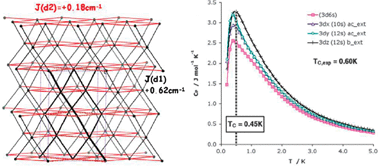Calculation of microscopic exchange interactions and modelling of macroscopic magnetic properties in molecule-based magnets†
Abstract
The state-of-the-art theoretical evaluation and rationalization of the magnetic interactions (JAB) in molecule-based magnets is discussed in this critical review, focusing first on isolated radical⋯radical pair interactions and afterwards on how these interactions cooperate in the solid phase. Concerning isolated radical pairwise magnetic interactions, an initial analysis is done on qualitative grounds, concentrating also on the validity of the most commonly used models to predict their size and angularity (namely, McConnell-I and McConnell-II models, overlap of magnetic orbitals,…). The failure of these models, caused by their oversimplified description of the magnetic interactions, prompted the introduction of quantitative approaches, whose basic principles and relative quality are also evaluated. Concerning the computation of magnetic interactions in solids, we resort to a sum of pairwise magnetic interactions within the Heisenberg Hamiltonian framework, and follow the First-principles Bottom-Up procedure, which allows the accurate study of the magnetic properties of any molecule-based magnet in an unbiased way. The basic principles of this approach are outlined, applied in detail to a model system, and finally demonstrated to properly describe the magnetic properties of molecule-based systems that show a variety of magnetic topologies, which range from 1D to 3D (152 references).

- This article is part of the themed collection: Molecule-based magnets

 Please wait while we load your content...
Please wait while we load your content...